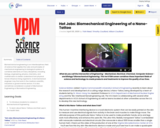
Conditional Remix & Share Permitted
CC BY-NC
Biomechanical engineering is an interdisciplinary field of science that applies the rules and principles of mechanical engineering to biological systems. It combines elements of many disciplines, including biology, engineering, physics, chemistry, and mathematics to better understand how physical forces influence living organisms. A biomechanical engineer may find work in the medical, scientific, industrial or governmental sectors. It is also sometimes considered a subset of Mechanical Engineering or Biomedical Engineering.
- Subject:
- CTE
- Career Connections
- Cross-Curricular
- Health and Medical Sciences
- STEM/STEAM
- Material Type:
- Visual Media
- Provider:
- VPM
- Date Added:
- 01/04/2020